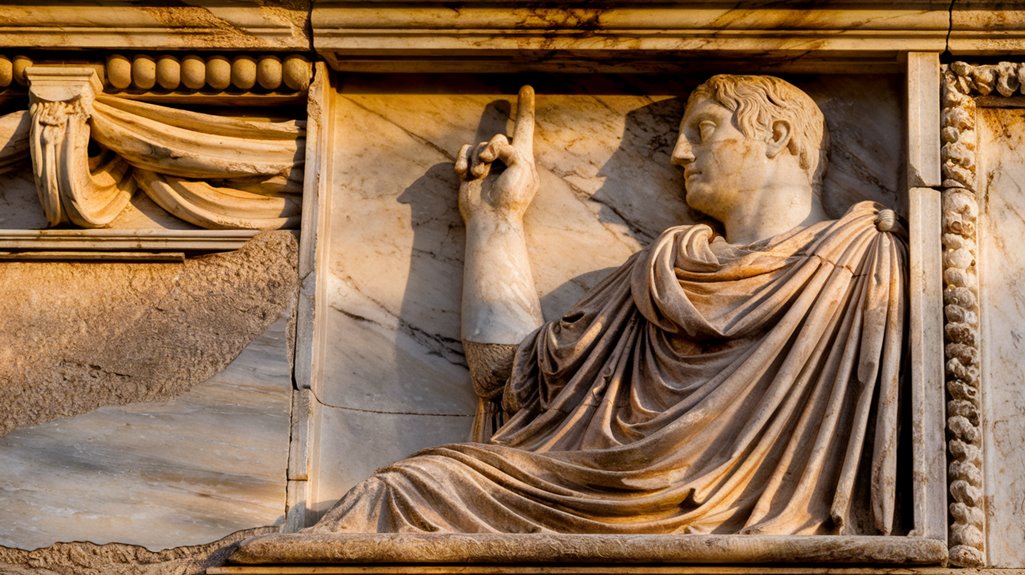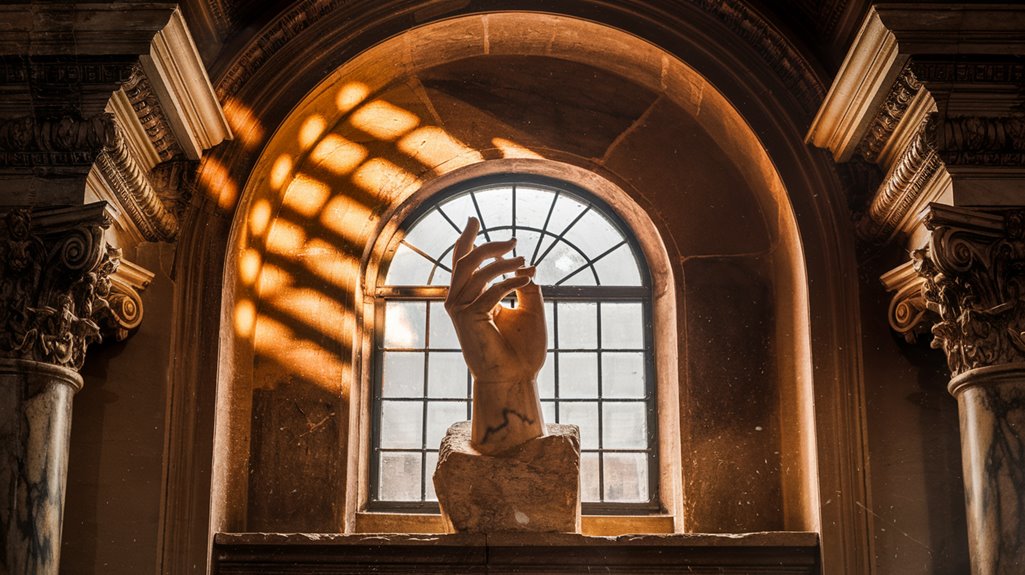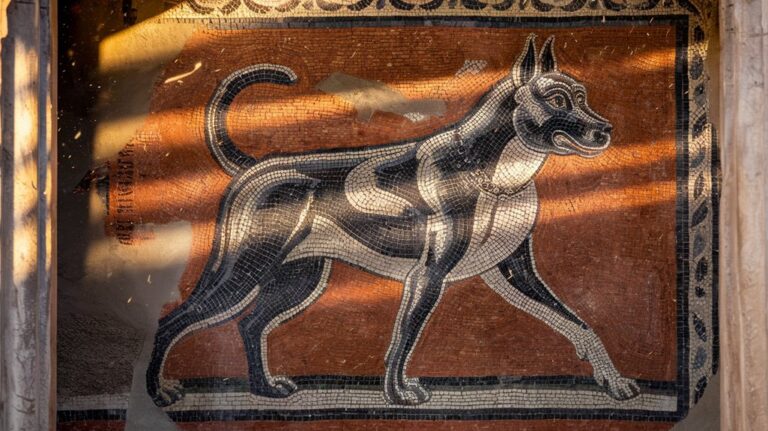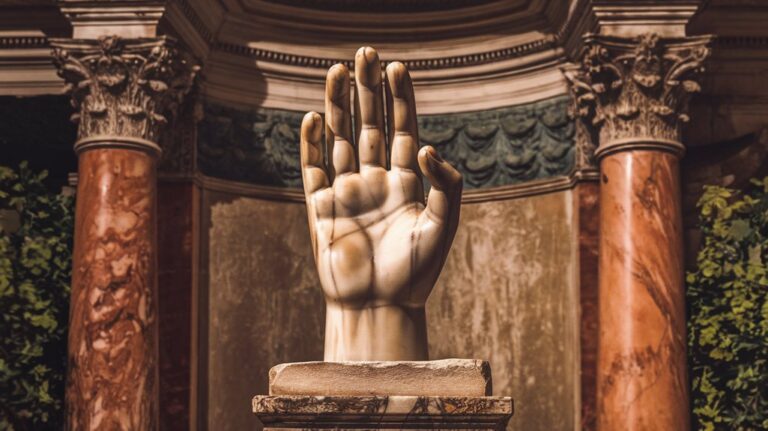Middle Finger Origins: a Rude Gesture From Ancient Rome
You've likely flashed or received the middle finger at some point in your life, but you might not realize you're participating in a gesture that's over 2,000 years old. This notorious symbol of disrespect, known as "digitus impudicus" to ancient Romans, carries a fascinating history of phallic imagery, protective rituals, and cultural taboos. From the streets of Rome to modern-day courtrooms, this simple hand signal has maintained its power to provoke and offend across millennia.
The Birth of an Ancient Insult
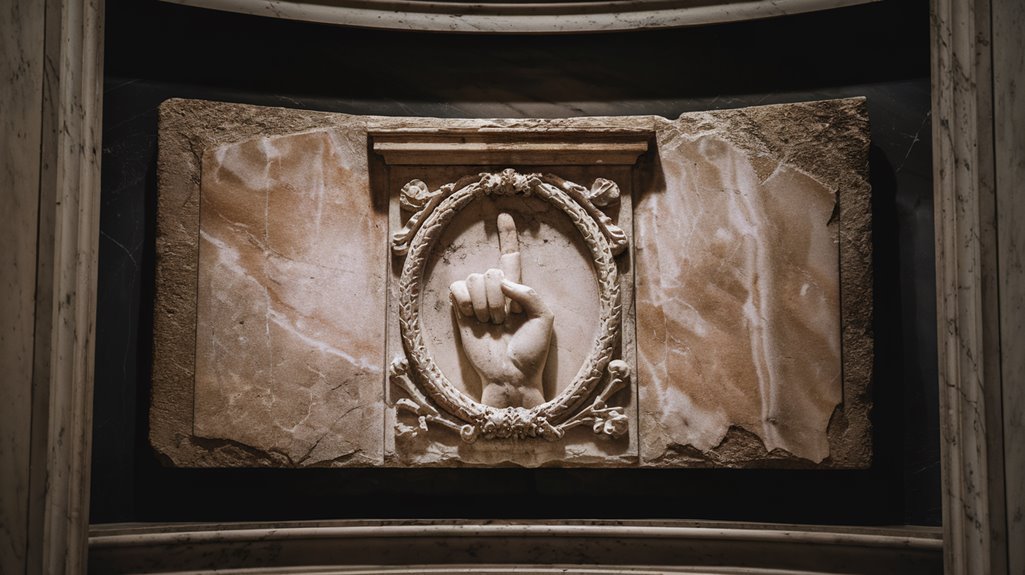
While many modern gestures come and go, the middle finger has maintained its status as a universal insult since ancient Roman times. The Romans called it "digitus impudicus," meaning the shameless or indecent finger, and its historical context reveals a striking similarity to today's offensive gestures.
The insult evolution of this gesture stems from its phallic symbolism, where curled fingers around the extended middle digit created an unmistakably vulgar display. Like many elements of Roman urban wit and communication, this gesture became a powerful tool in the repertoire of public discourse. Early Christians considered this gesture particularly offensive, referring to it as the manus obscena in their writings.
You'll find references to this gesture in ancient Roman texts, including Martial's works and Isidore of Seville's writings, where it's described as a way to accuse someone of "shameful action."
In late antiquity, this gesture became deeply embedded in Roman culture, where public insults played a significant role in political and social discourse.
Roman Society and Obscene Gestures
Ancient Roman society's relationship with obscene gestures extended far beyond casual insults, reaching into the highest levels of culture and politics. You'd find these gestures used by everyone from common citizens to public figures, with even the famous actor Pylades facing punishment from Emperor Augustus for using the digitus impudicus.
Roman traditions around obscene gestures were deeply rooted in their cultural beliefs. While you might think these gestures were purely offensive, they often served multiple purposes. The widespread presence of erotic art and paintings in noble households demonstrated Romans' comfort with explicit imagery.
The Romans incorporated phallic symbols and gestures into their daily lives, believing they could ward off evil spirits. The middle finger and fig sign weren't just insults – they were part of a complex system of magical protection and religious ritual that reflected Rome's unique relationship with sexuality and spirituality.
Greek Comedy and Sexual Symbolism
Sexual humor played a central role in Greek Old Comedy, serving as more than just cheap laughs for the audience. You'll find these performances cleverly wove sexual innuendos into complex political and social commentary, with characters often using suggestive language and double entendres to advance the plot.
The comedic devices extended beyond mere wordplay. Playwrights like Aristophanes used symbolic locations like the Acropolis and objects like wine to deepen their satirical messages. The temple's strategic importance was emphasized when women used the goddess of wisdom Athena's sacred space to achieve their peaceful aims. The earliest documented evidence of the middle finger gesture appears in Aristophanes' play "The Clouds" where it was used to mock Socrates.
You'd see male characters sporting visible erections as running jokes, while slave characters delivered transgressive sexual humor that challenged social hierarchies. This strategic use of sexuality wasn't gratuitous – it helped blur social distinctions and engage audiences across class lines, making the political messaging more accessible and memorable.
The Evil Eye and Protective Rituals
Beliefs in the evil eye's malevolent power have persisted across cultures for over 7,000 years, from ancient Egyptian civilization through modern times.
You'll find protective rituals combining both pagan and monotheistic practices, with approximately 40% of world cultures acknowledging this phenomenon.
To shield yourself from the evil eye, practitioners recommend various protective measures:
- Using water and oil in diagnostic and healing ceremonies
- Wearing colored amulets (blue for protection, orange for happiness)
- Performing "xematiasma" with prayers and cross symbols
- Utilizing tools like silver knives, scissors, or pins in banishing rituals
These protective traditions blend ancient wisdom with modern practices, as evidenced by the popularity of evil eye jewelry. Middle finger gestures originated as a response to ward off the evil eye in ancient Roman society. Many practitioners enhance their protection by anointing with oil, which is believed to create a powerful energetic shield.
You'll notice these symbols everywhere from fashion accessories to religious ceremonies, highlighting humanity's enduring belief in spiritual protection.
From Ancient Rome to Modern Times
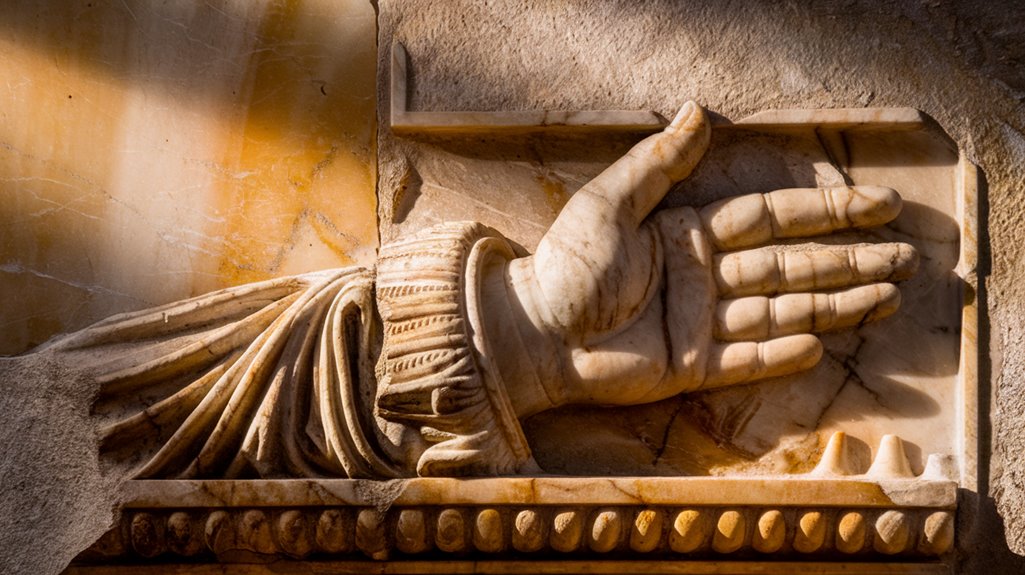
While cultures developed various ways to ward off evil forces, they also created powerful gestures to express defiance and disrespect. One of the most enduring ancient gestures is the middle finger, which emerged in ancient Greece and flourished in Rome as the "digitus impudicus." You'll find its earliest documented use in Greek plays from 419 BC.
The cultural evolution of this gesture is fascinating. When Romans adopted it, they enhanced its obscene symbolism, with Emperor Caligula even forcing subjects to kiss his middle finger as a form of degradation.
As European migration spread to America, the gesture's impact grew stronger. Today, you'll see its influence across movies, sports, and music, sparking controversies and debates. The middle finger has truly survived centuries to become one of today's most recognized symbols of defiance.
Cultural Impact and Legal Standing
As society evolved, the middle finger's impact extended far beyond its ancient roots to become both a cultural phenomenon and a legal battleground.
The gesture's cultural significance transcends language barriers, serving as a universal symbol of contempt that's deeply embedded in modern society. What began as a protective Roman symbol gradually transformed into an expression of disrespect over centuries.
Legal implications surrounding this gesture have sparked numerous court battles, with most U.S. courts protecting it under First Amendment rights. Courts like the Sixth Circuit have consistently ruled that extending the middle finger is constitutionally protected expression.
You'll find it's generally considered protected speech unless accompanied by truly disruptive behavior.
Key aspects of the middle finger's modern status include:
- Universal recognition across cultures as an offensive gesture
- Protected status under First Amendment in most U.S. jurisdictions
- Frequent appearances in pop culture and media
- Complex legal interpretations varying by context and jurisdiction

